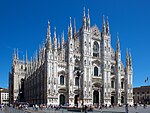Roman Catholic Archdiocese of Milan

The Archdiocese of Milan (Italian: Arcidiocesi di Milano; Latin: Archidioecesis Mediolanensis) is a Latin Church ecclesiastical territory or archdiocese of the Catholic Church in Italy which covers the areas of Milan, Monza, Lecco and Varese. It has long maintained its own Latin liturgical rite usage, the Ambrosian rite, which is still used in the greater part of the diocesan territory. Among its past archbishops, the better known are Saint Ambrose, Saint Charles Borromeo, Pope Pius XI and Saint Pope Paul VI. The Archdiocese of Milan is the metropolitan see of the ecclesiastical province of Milan, which includes the suffragan dioceses of Bergamo, Brescia, Como, Crema, Cremona, Lodi, Mantova, Pavia, and Vigevano.Milan's Archdiocese is the largest in Europe, and the one having the most priests in the world, with 2,648 priests living in the diocese, among which 1,861 are secular priests.
Excerpt from the Wikipedia article Roman Catholic Archdiocese of Milan (License: CC BY-SA 3.0, Authors, Images).Roman Catholic Archdiocese of Milan
Piazza del Duomo, Milan Municipio 1
Geographical coordinates (GPS) Address Phone number Website Nearby Places Show on map
Geographical coordinates (GPS)
| Latitude | Longitude |
|---|---|
| N 45.464308333333 ° | E 9.1918444444444 ° |
Address
Duomo di Milano
Piazza del Duomo
20122 Milan, Municipio 1
Lombardy, Italy
Open on Google Maps










